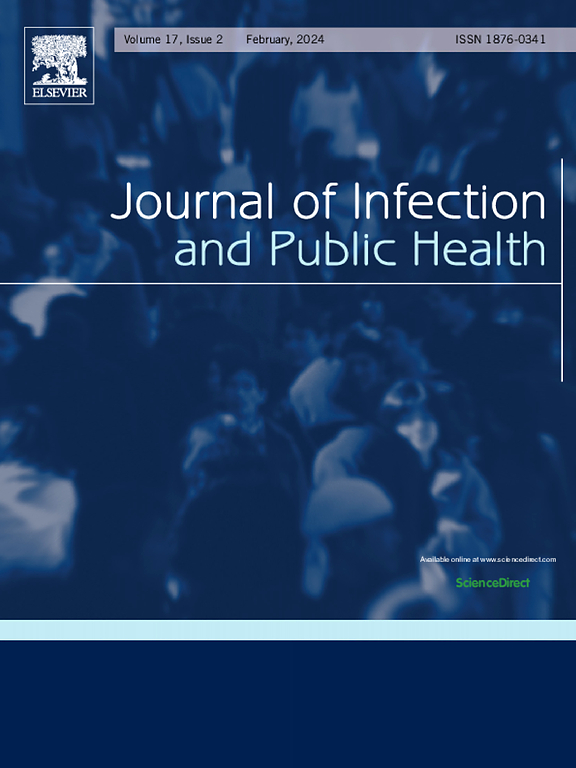Evaluation of a multiplex genomic point-of-care strategy for rapid support of older people with respiratory infection in a geriatric hospital over a full winter season
IF 4.7
3区 医学
Q1 INFECTIOUS DISEASES
引用次数: 0
Abstract
Background
In older patients, it is important to rapidly identify those infected by a significant pathogen in order to implement isolation measures and prescribe appropriate specific treatments when available and indicated. The objective of this study was to evaluate a multiplex genomic point-of-care (POC) strategy detecting four viruses, SARS-CoV-2, influenza virus (IV) A and B and respiratory syncytial virus (RSV), in a geriatric setting located 7 km from the central laboratory of the hospital.
Methods
This prospective monocentric study was conducted during the 2022–2023 winter season in two geriatric wards of the University Hospital of Saint-Etienne, France. Two automated quantitative reverse transcription polymerase chain reaction (RT-qPCR) tests were compared, the reference test at the central laboratory and the POC test performed by nurses. The main outcome was the saved time to result (TTR) by the clinician with the POC technology. Additional objectives included testing performance, health-economic considerations and healthcare workers’ acceptability.
Results
From 69 included infectious episodes, the reference test identified 18 viral infections (7 for SARS-CoV-2, 8 for RSV, 2 for both viruses, 1 for IVA). The POC test yielded similar performance with reference test (overall concordance of 98.55 % for SARS-CoV-2 and RSV). The POC strategy showed a gain of 10.43 ( ± 6.92) hours on TTR and a cumulative time of isolation of 488.27 hours in case of negative result. Further results showed economic savings and a strong acceptability by healthcare workers in favor of the POC strategy.
Conclusions
This pilot study illustrates the benefits of a genomic POC test to identify current respiratory viral infections in older people within a geriatric setting remote from the central laboratory during a winter season with multiple viral outbreaks.
对老年医院呼吸道感染老年人整个冬季快速支持的多重基因组点护理策略进行评估
背景:在老年患者中,快速识别被重要病原体感染的患者非常重要,以便实施隔离措施,并在可行和有指示的情况下规定适当的特异性治疗。本研究的目的是评估在距离医院中心实验室7 公里的老年环境中检测SARS-CoV-2、流感病毒(IV) a和B以及呼吸道合胞病毒(RSV)四种病毒的多重基因组点护理(POC)策略。方法本前瞻性单中心研究于2022-2023年冬季在法国圣艾蒂安大学医院的两个老年病房进行。比较两种自动定量反转录聚合酶链反应(RT-qPCR)检测方法,中心实验室参考检测方法和护士进行的POC检测方法。主要结果是临床医生使用POC技术节省的到结果时间(TTR)。其他目标包括检测性能、卫生经济考虑和卫生保健工作者的可接受性。结果从69例纳入的感染事件中,参考试验鉴定出18例病毒感染(SARS-CoV-2 7例,RSV 8例,两种病毒2例,IVA 1例)。POC测试结果与参考测试结果相似(SARS-CoV-2和RSV的总体一致性为98.55 %)。POC策略的TTR增加10.43( ± 6.92)小时,阴性时的累计隔离时间为488.27 小时。进一步的结果显示经济上的节约和医疗工作者对POC策略的强烈接受。这项初步研究说明了基因组POC测试在远离中心实验室的老年环境中识别当前呼吸道病毒感染的益处,特别是在多次病毒暴发的冬季。
本文章由计算机程序翻译,如有差异,请以英文原文为准。
求助全文
约1分钟内获得全文
求助全文
来源期刊

Journal of Infection and Public Health
PUBLIC, ENVIRONMENTAL & OCCUPATIONAL HEALTH -INFECTIOUS DISEASES
CiteScore
13.10
自引率
1.50%
发文量
203
审稿时长
96 days
期刊介绍:
The Journal of Infection and Public Health, first official journal of the Saudi Arabian Ministry of National Guard Health Affairs, King Saud Bin Abdulaziz University for Health Sciences and the Saudi Association for Public Health, aims to be the foremost scientific, peer-reviewed journal encompassing infection prevention and control, microbiology, infectious diseases, public health and the application of healthcare epidemiology to the evaluation of health outcomes. The point of view of the journal is that infection and public health are closely intertwined and that advances in one area will have positive consequences on the other.
The journal will be useful to all health professionals who are partners in the management of patients with communicable diseases, keeping them up to date. The journal is proud to have an international and diverse editorial board that will assist and facilitate the publication of articles that reflect a global view on infection control and public health, as well as emphasizing our focus on supporting the needs of public health practitioners.
It is our aim to improve healthcare by reducing risk of infection and related adverse outcomes by critical review, selection, and dissemination of new and relevant information in the field of infection control, public health and infectious diseases in all healthcare settings and the community.
 求助内容:
求助内容: 应助结果提醒方式:
应助结果提醒方式:


